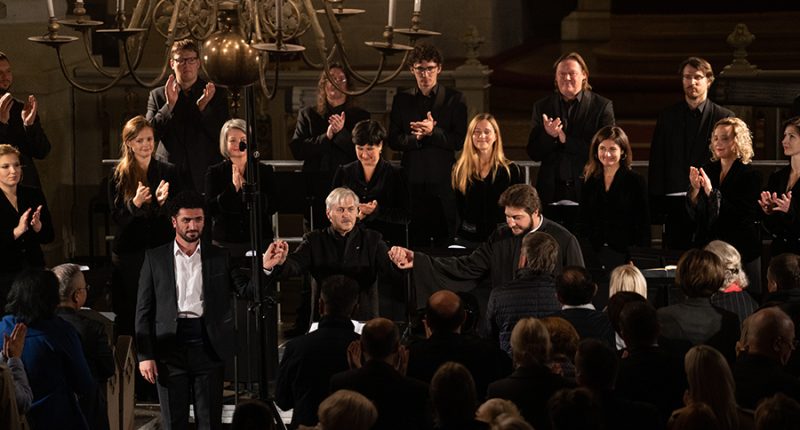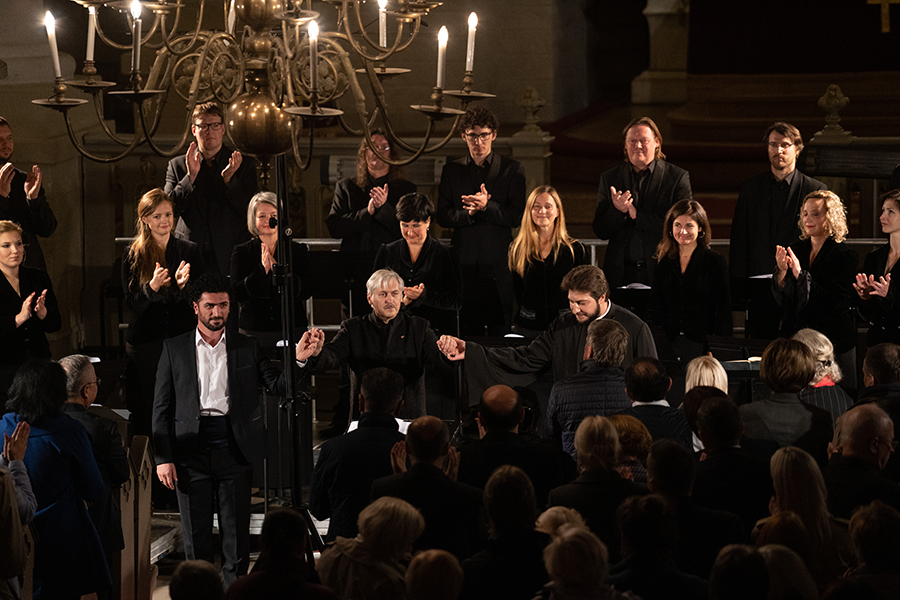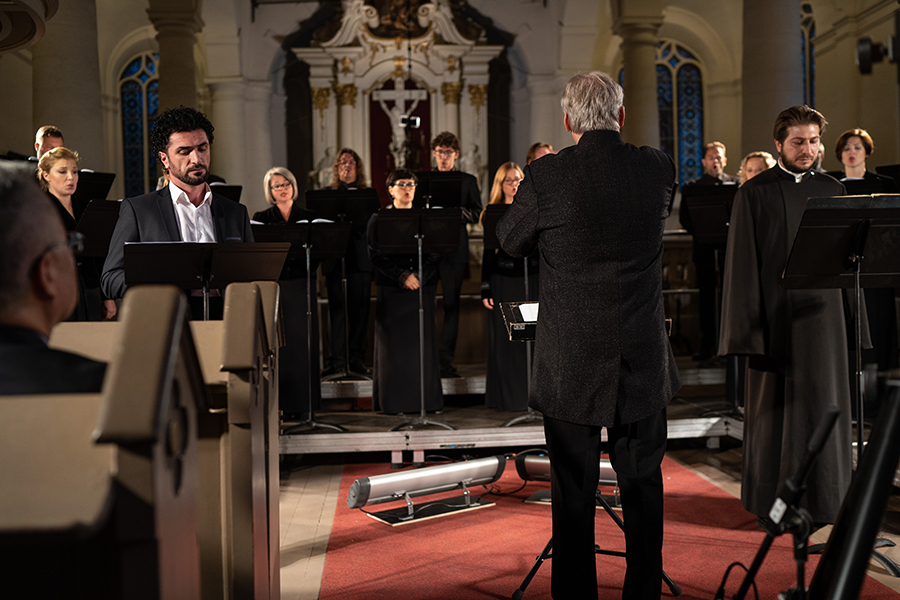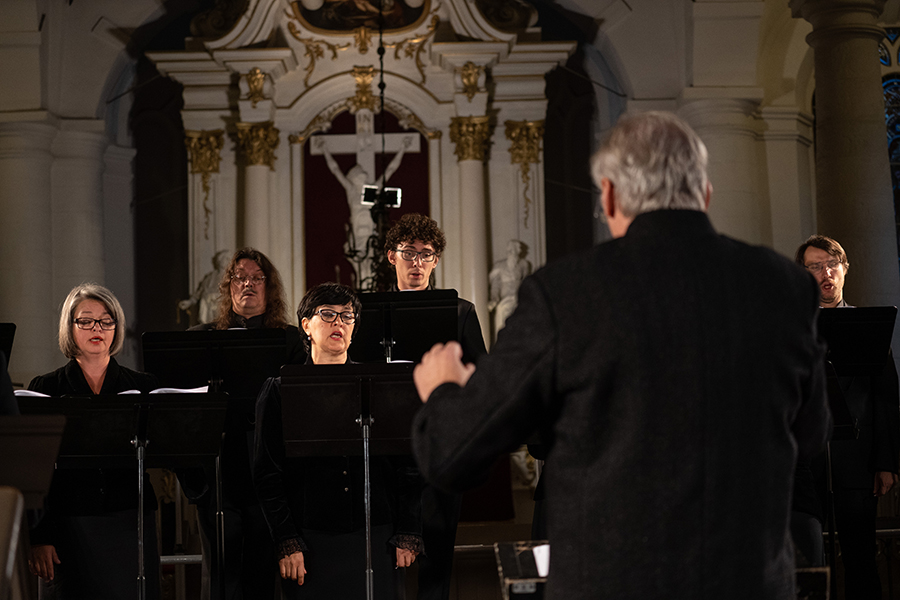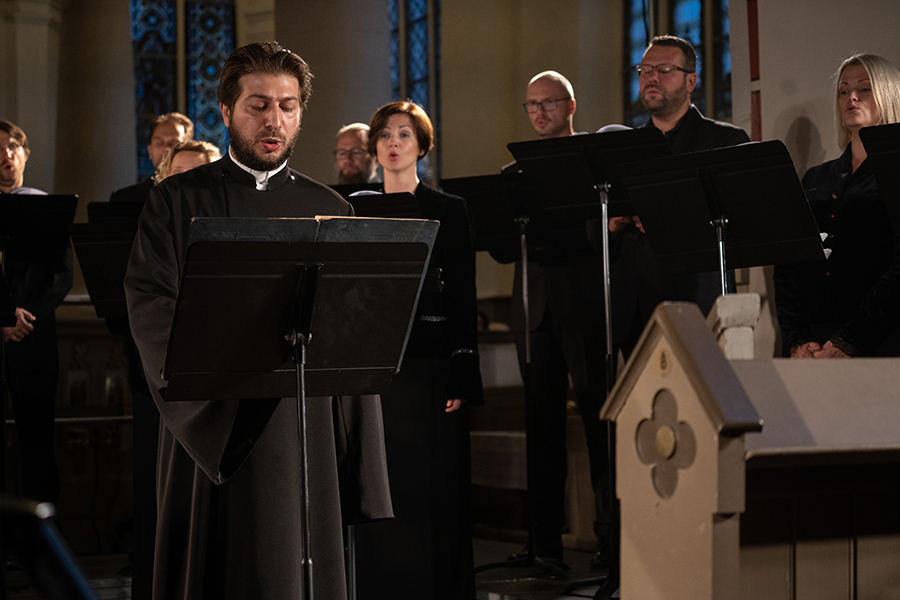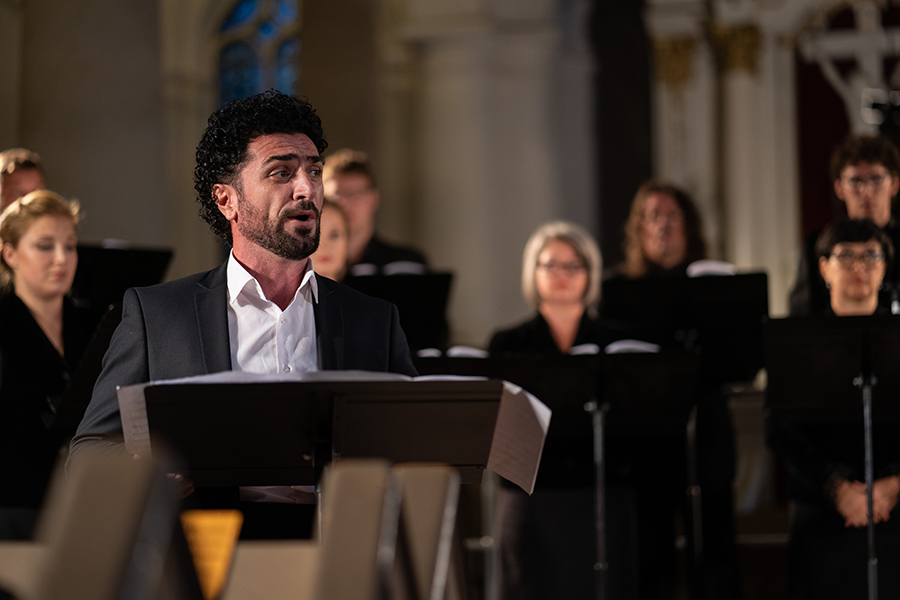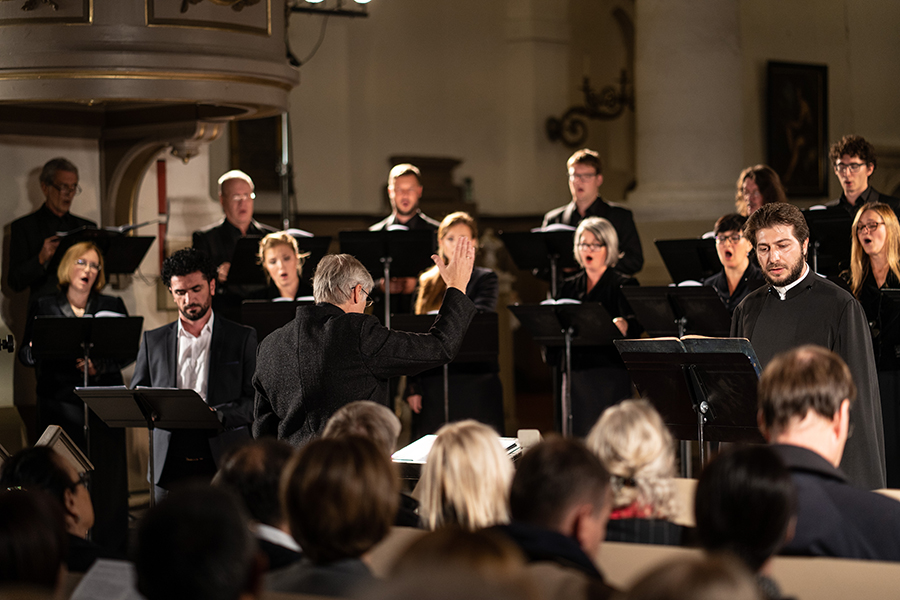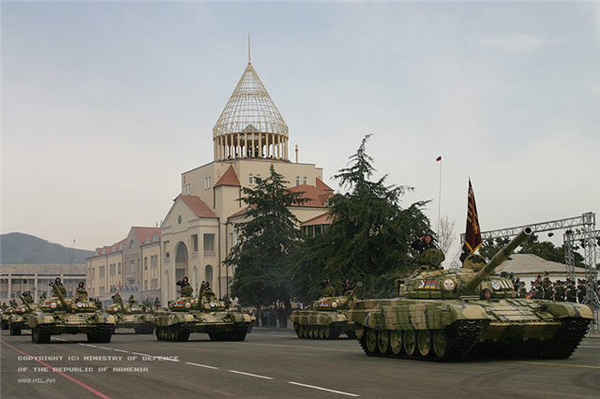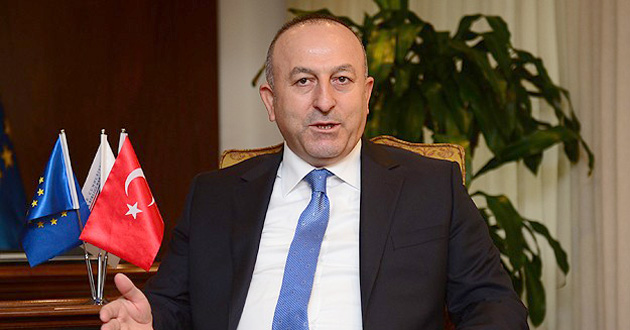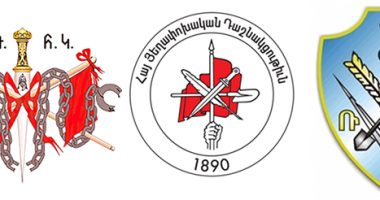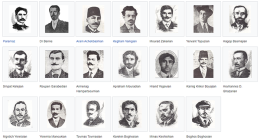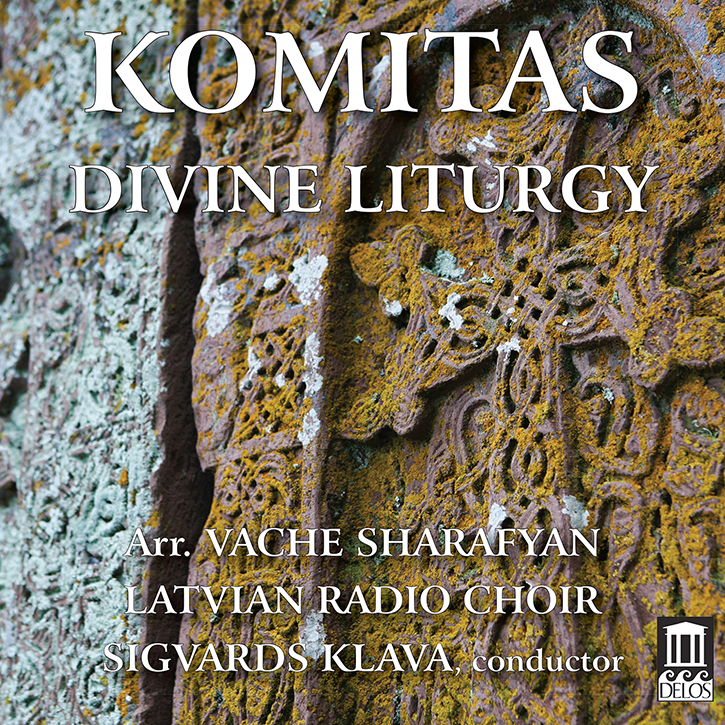

Three years ago, Ambassador Tigran Mkrtchyan embarked on a journey to pay homage to the father of Armenian classical music, Komitas Vardapet, resulting in a rich musical album titled Komitas: Divine Liturgy, released by DELOS records on July 10.
After years of planning and collaboration led by the Ambassador, the 150th anniversary concert honoring Komitas Vardapet and his Divine Liturgy by the Latvian Radio Choir, under the artistic direction of composer Sigvards Klava, was held at St. John’s Church in Riga, Latvia. The concert in September of last year, was recorded, giving birth to the newly released album with the musical arrangement of composer Vache Sharafyan, featuring Komitas’ final works just before his deportation during the Genocide.
The Latvian Radio Choir, the first non-Armenian speaking mixed choir to perform Komitas’ liturgies, is accompanied by award-wining soloist Deacon Hovhanness Nersesyan (bass) of the Araratian Pontifical Diocese and tenor Armen Badalyan, both of whom are graduates of the Komitas State Conservatory in Yerevan, soloists at the Armenian National Academic Theatre of Opera and Ballet and vocalists at the Etchmiadzin Cathedral.
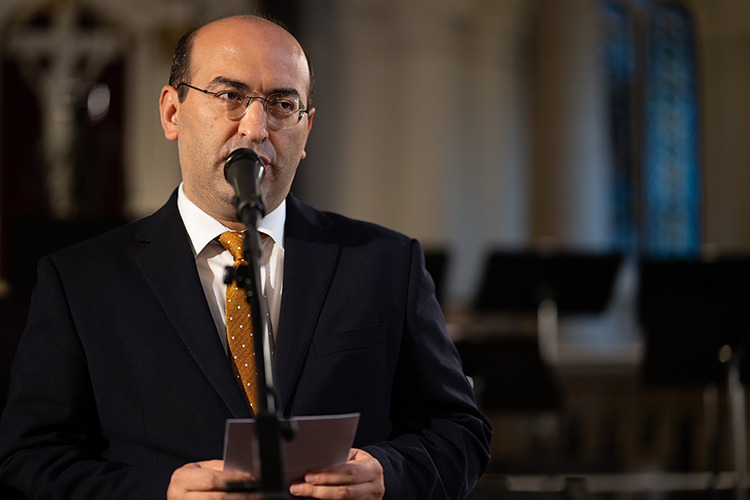

Ambassador Mkrtchyan explains that the inception of the project was initiated when he asked the Latvian Radio Choir to perform a few of Komitas’ pieces during their concerts. The performances were such a success, that he was convinced the choir could masterfully perform an entire concert of Komitas’ works. That is when conductor Sigvards Klava decided to travel to Armenia and stay at the Holy See of Etchmiadzin for inspiration, along with the collaboration of famed Armenian composer Vache Sharafyan.
“He [Klava] wanted, he needed to feel closer to the Armenian religious life, spiritual music and Komitas,“ said Ambassador Mkrtchyan. “So, a few days spent in Etchmiadzin and Yerevan, meetings with Komitas scholars, visits to religious sites in Armenia were of immense importance to bring Mr. Klava closer to Armenian culture. Later we invited from Paris, Mkrtich Mkrtchyan, a musician and Komitas scholar, to work with the choir, to present the Armenian musical traditions and Komitas. The singers also visited the Armenian Apostolic Church in Riga and had a meeting with Ter Khosrov Stepanyan, who presented them the Armenian religious traditions and spiritual music. Thus, it took three long years to mature this project, and then it was time to prepare for the recording itself,” he added.
In 1892, Komitas began working on the Divine Liturgy, his final work with ten versions, all of which were created for male choirs. The final version, presented on the album, dates from 1914-1915, just before Komitas’ deportation from Constantinople to a prison camp in Cankin.
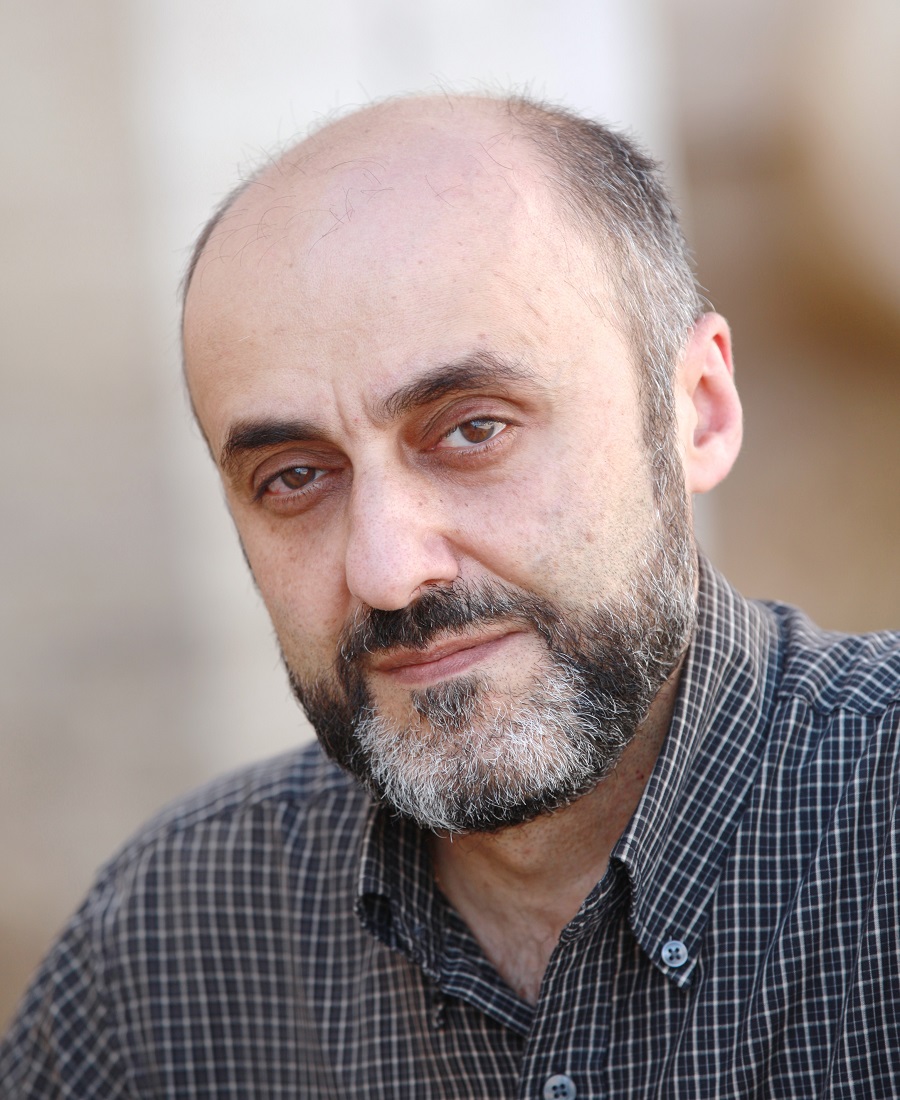

Composer Vache Sharafyan believes that the original male version was written to be sang during church liturgies while the mixed choir version of the musical score he transliterated to Latin is more suitable for stage performances.
“The male choir and mixed choir have very different types of the musicality, timbres, colors etc.,” Sharafyan explains. “It was important to create a version of Komitas’ Liturgy based on his male choir version that could be sang by the mixed choirs, because there are more mixed choirs in the world. Meanwhile it was also very important to keep the music as close to the original male version of Komitas’ idea as possible and also to use the richness of the vocal beauty of the female and male voice combinations and to create a complete mixed choir version. I am sure that if Komitas had a chance to work after 1915, he would have definitely created such a version himself. But unfortunately, after the 1915 Armenian Genocide in Ottoman Turkey and until the end of his life in 1935, Komitas was in the hospital for mental illnesses in Paris and never wrote another note,” he added.
Ambassador Mkrtchyan discussed some of the challenges of having a non-Armenian speaking choir conduct the liturgies and attributes this phenomenon to the fact that the liturgy is written in Armenian for an all-male choir. He also explained how those obstacles were overcome with a lot of hard work and determination.
“Komitas Vardapet has left us one of the most beautiful liturgies in the history of music,” revealed Ambassador Mkrtchyan. “Soloists simply have to be Armenian or be fluent in Armenian as the parts for the tenor and bass can be performed only by such persons. But during our long and painstaking preparations, we managed to address all of these issues, I hope, successfully. First, Mr. Mkrtchyan worked with the choir, also on their Armenian, presented them nuances of Armenian spiritual music. Then a Latvian scholar of Armenian studies, Valda Salmina, worked with them on their Armenian. And eventually Vache Sharafyan worked with the singers both before the concert and during the recording. Therefore, I dare say, the choir sounds like an Armenian choir,” he added.
Composer Sharafyan talked about his experience working on the album: “I had great time working with the Latvian Radio Choir and its choirmaster Sigvards Klava. The Latvian Radio Choir consists of wonderful musicians and has a unique rich timbre and ability to open and express the very hidden spirituality and nuances in the music. It was also very important to have the Armenian wonderful soloists Armen Badalyan and Hovhannes Nersesyan … They helped a lot to keep the Armenianness of the whole sound.”
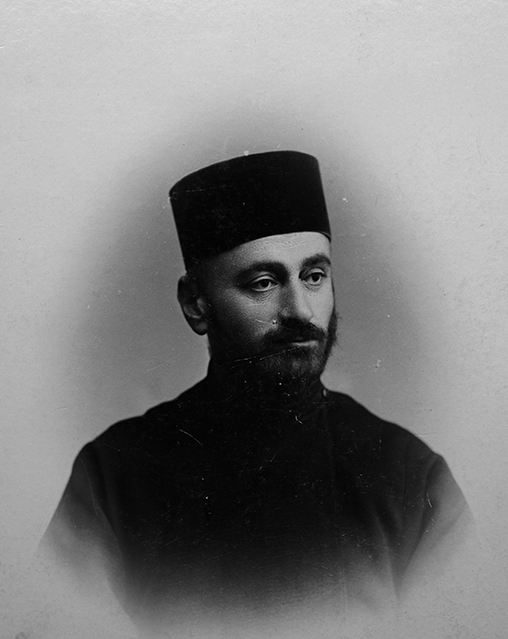

Komitas collected, transcribed and researched more than 3000 pieces of Armenian folk music. Most of it has disappeared and only about 1200 pieces are in existence today. He arranged authentic folk songs of rural peasants turning simple material into beautifully sophisticated polyphony. It is said that Komitas did for Armenia what Bartók did for Hungary. He had a voracious appetite for songs, and his transcriptions reflect a remarkable ear, seamlessly interweaving threads of music, movement, and complex social relationships.
Ambassador Mkrchyan believes it is vital for the next generation to preserve Komitas’ legacy: “I think, the Armenian youth especially needs to know more about Komitas Vardapet’s contributions to the Armenian culture and arts, because Komitas is one of the strongest pillars on which Armenian cultural identity is based,” he said. “Thanks to him, we have several hundreds of unique sacred and spiritual songs, which he spared no effort to collect from around the Western Armenia. At the same time, Komitas having studied in Europe, knew very well what the uniqueness of Armenian culture was in the context of western civilization and how best to present it to international audience. I would say that the more we know his music, the more we know of him, the closer we are to our roots,” he added.
The album itself is accompanied by a booklet featuring the entire text of the liturgy in Armenian translated to English with Latin transliteration, allowing the listener of the recordings to sing along with the album. Also included is Komitas’ autobiography translated to English along with written sections about the life and music of Komitas by Vache Sharafyan and Vache Barsoumian.
“Komitas summarizes the collective consciousness of the Armenian nation, our aspirations and pain,” said Ambassador Mkrtchyan. “As we know all of his music was created before April 1915, before life stopped in the biggest part of the historical fatherland of Armenians, as the horrors of the Armenian Genocide which he witnessed were too much for a human being to tolerate. I hope Komitas gets a much wider and better recognition worldwide,” he added.
Composer Sharafyan also believes Komitas’ work should be better known around the world. He states that the music of Bach, Mozart and Beethoven is widely known because those men were from European countries where they had the opportunity to create art that was performed for audiences all over the world.
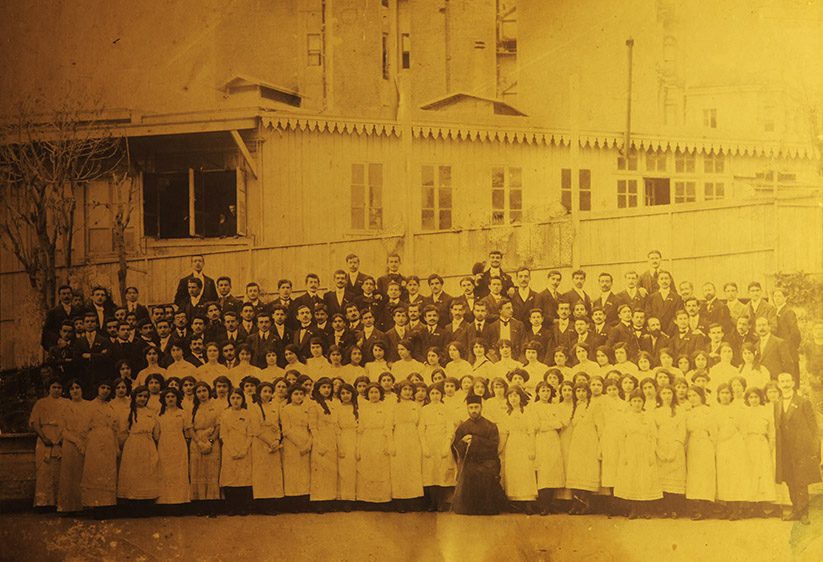

“Komitas was born in a country where there wasn’t real art life,” said Sharafyan. “There was poverty, occupation, invasion, genocide, war, there was the question of the existence of the Armenian nation and no real art life was possible in such a situation. Komitas studied in Berlin and found and established an absolutely new approach to the music based on the national value and discovered another sense of harmony, polyphony, melody. Throughout history we know many examples when music of the great composers are rediscovered later and I am sure Komitas is the one whose art is deserving to be discovered by the world,” he added.
According to Ambassador Mkrtchyan, future cultural events and concerts in Estonia featuring the Liturgy of Komitas and Tigran Mansuran’s Requiem in Kaunas with Grammy Award winning choirs have been postponed due the to the COVID-19 pandemic. “From amongst the supporters I would like to thank specifically the Ministry of Education, Science, Culture and Sport of Armenia for acknowledging the significance of this project and stepping in with its considerable support,” said Ambassador Mkrtchyan. “Sigvards Klava was hosted in the Holy See of Etchmiadzin by the invitation of His Holiness Catholicos Karekin II, the supreme head of the Armenian Apostolic Church. The Armenian Apostolic Church in Riga and Ter Khosrov Stepanyan did an amazing job in presenting the Latvian Radio Choir with Armenian spiritual music traditions and I would like to thank Ter Khosrov for that. I would like to thank also OrganiQ company, and especially Ovik Mkrtchyan and Mkhitar Mkhitaryan for their generous support without which this idea would not be realized. Aram Arutyunyan was of great support as well. And also I would like to thank our sponsors from Armenia, the Balasanyan Family Foundation whose contribution to the Armenian musicians’ participation in this concert has been vital.
For more information on Komitas: Divine Liturgy, visit: https://delosmusic.com

